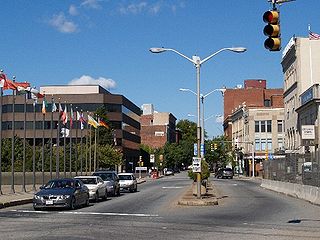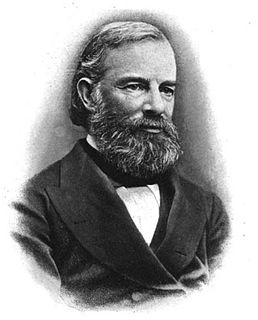
King's Chapel is an independent Christian unitarian congregation affiliated with the Unitarian Universalist Association that is "unitarian Christian in theology, Anglican in worship, and congregational in governance." It is housed in what was formerly called "Stone Chapel", an 18th-century structure at the corner of Tremont Street and School Street in Boston, Massachusetts. The chapel building, completed in 1754, is one of the finest designs of the noted colonial architect Peter Harrison, and was designated a National Historic Landmark in 1960 for its architectural significance.

The Wadsworth-Longfellow House is a historic house and museum in Portland, Maine, United States. It is located at 489 Congress Street and is operated by the Maine Historical Society. It was designated a National Historic Landmark in 1962, and administratively added to the National Register of Historic Places in 1966. The house is open daily to public from May through October. An admission fee is charged.

The Longfellow House–Washington's Headquarters National Historic Site is a historic site located at 105 Brattle Street in Cambridge, Massachusetts. It was the home of noted American poet Henry Wadsworth Longfellow for almost 50 years, and it had previously served as the headquarters of General George Washington (1775-76).

Longfellow is a defined community in Minneapolis, Minnesota which includes five smaller neighborhoods inside of it: Cooper, Hiawatha, Howe, Seward, and Longfellow. Grouped with South Minneapolis between the city's eastern border with the Mississippi River and the Metro Blue Line, Longfellow takes its name from Longfellow neighborhood which in turn is named after Henry Wadsworth Longfellow. The renowned American poet incorporated elements into his poem The Song of Hiawatha from Henry Schoolcraft's accounts of native Dakota lore in Minnesota which included Minnehaha Falls in Longfellow's southern tip. The early reference of Highway 55 as Hiawatha Avenue, along the west border, may have influenced the naming decision when community borders were drawn in the 1960s. Hiawatha Avenue is the main thoroughfare leading north into Downtown Minneapolis and south to the Minneapolis-Saint Paul Airport.

The Oliver Hastings House is a historic house at 101 Brattle Street, Cambridge, Massachusetts. It is a National Historic Landmark, noted as an excellent example of Greek Revival architecture. It was the home of Oliver Hastings, a local builder.
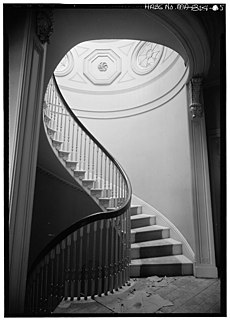
The Nathan Appleton Residence, also known as the Appleton-Parker House, is a historic house located at 39–40 Beacon Street in the Beacon Hill neighborhood of Boston, Massachusetts. It was designated a National Historic Landmark for its association with revolutionary textile manufacturer Nathan Appleton (1779–1861), and as the site in 1843 of the wedding of his daughter Frances and poet Henry Wadsworth Longfellow. The house is an excellent early 19th century design of Alexander Parris.

First Unitarian Congregational Society in Brooklyn is a Unitarian Universalist congregation in Brooklyn, NY. The Society was established in 1833 and has been worshipping in its historic Gothic Revival Sanctuary since 1844. It is one of the earliest Unitarian congregations in the United States, established just 8 years after the American Unitarian Association was formed in 1825.

The First Baptist Church is an historic American Baptist Churches USA congregation, established in 1665. It is one of the oldest Baptist churches in the United States. It first met secretly in members homes, and the doors of the first church were nailed shut by a decree from the Puritans in March 1680. The church was forced to move to Noddle's Island. The church was forced to be disguised as a tavern and members traveled by water to worship. Rev. Dr. Stillman led the church in the North End for over 40 years, from 1764 to 1807. The church moved to Beacon Hill in 1854, where it was the tallest steeple in the city. After a slow demise under Rev. Dr. Rollin Heber Neale, the church briefly joined with the Shawmut Ave. Church, and the Warren Avenue Tabernacle, and merged and bought the current church in 1881, for $100,000.00. Since 1882 it has been located at the corner of Commonwealth Avenue and Clarendon Street in the Back Bay. The interior is a pending Boston Landmark.
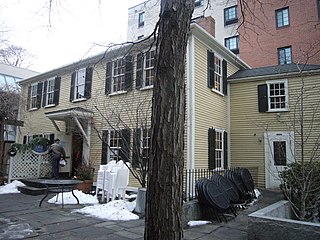
The Dexter Pratt House is an historic house at 54 Brattle Street in Cambridge, Massachusetts. It is remembered as the home of Dexter Pratt, the blacksmith who inspired the poem "The Village Blacksmith" by Henry Wadsworth Longfellow.

The Center Village District encompasses the historic village center of Lancaster, Massachusetts. Settled in 1643, it has few traces of its early history, but is now a well-kept rural town center with a predominantly residential and civic character. It includes the First Church of Christ, Lancaster, which is a U.S. National Historic Landmark, and was listed on the National Register of Historic Places in 1977.

The Church of the Ascension is a historic Episcopal church building located at 160 Rock Street in Fall River, Massachusetts. It was completed in 1875 and added to the National Register of Historic Places in 1983. It is also located within the Lower Highlands Historic District.
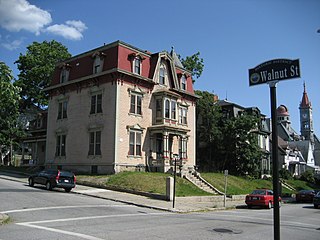
The Highlands Historic District is a historic district roughly bounded by June, Cherry, and Weetamoe Streets, Lincoln, Highland, President, North Main, and Hood Avenues in Fall River, Massachusetts. The district lies just north of the Lower Highlands Historic District.

The Joshua Lewis House is a historic house at 178 South Street in Needham, Massachusetts. Built in 1776, it has a well-preserved example of late Georgian architecture, which has been home to a number of individuals of local and national importance, including artist N.C. Wyeth. It was listed on the National Register of Historic Places in 1982.

The Wayside Inn Historic District is a historic district on Old Boston Post Road in Sudbury, Massachusetts. The district contains the famous Wayside Inn, a historic landmark inn that is reputedly the oldest operating inn in the country, opening as Howe's Tavern in 1716. The district features Greek Revival and Colonial architecture. The area was added to the National Register of Historic Places in 1973.
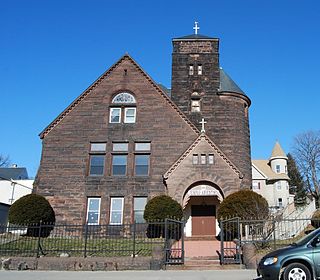
The South Unitarian Church is an historic church building at 888 Main Street in the Main South neighborhood of Worcester, Massachusetts. The Romanesque Revival building was designed by Earle & Fisher and was built by the Norcross Brothers in 1894 for the South Unitarian Society, established in 1890. The building is made of sandstone blocks, laid in courses alternating in width. The front (eastern) facade features a high pitched gable, with two rows of three windows, then a pair of windows topped by a large half-round window To the right is the church entrance, a smaller projecting gable section with a doorway recessed in a round archway, topped by three smaller windows. To the rear behind the entrance is a square tower with a partial half-round side tower.

The Henry Wadsworth Longfellow Monument is a public monument in Portland, Maine's West End. Located on the corner of State and Congress Street, it honors poet Henry Wadsworth Longfellow, who was born in Portland in 1807. The intersection built around the monument is known as Longfellow Square.

Brattle Street in Cambridge, Massachusetts, called the "King's Highway" or "Tory Row" before the American Revolutionary War, is the site of many buildings of historic interest, including the modernist glass-and-concrete building that housed the Design Research store, and a Georgian mansion where George Washington and Henry Wadsworth Longfellow both lived Samuel Atkins Eliot, writing in 1913 about the seven Colonial mansions of Brattle Street's "Tory Row," called the area "not only one of the most beautiful but also one of the most historic streets in America." "As a fashionable address it is doubtful if any other residential street in this country has enjoyed such long and uninterrupted prestige."

The Charlestown Main Street Historic District encompasses the historic heart of Charlestown, New Hampshire. It is located along Main Street, roughly between Lower Landing Road and Bridge Street, and encapsulates more than two hundred years of the town's history. The district was listed on the National Register of Historic Places in 1987.

Wadsworth Hall, also known as the Peleg Wadsworth House, is a historic house at the end of Douglas Road in Hiram, Maine, United States. A massive structure for a rural setting, it was built for General Peleg Wadsworth between 1800 and 1807 on a large tract of land granted to him for his service in the American Revolutionary War. Wadsworth was the leading citizen of Hiram, and important town meetings took place at the house. He was also the grandfather of poet Henry Wadsworth Longfellow, who visited the estate as a youth. The house remains in the hands of Wadsworth descendants. The house was listed on the National Register of Historic Places in 1974.

